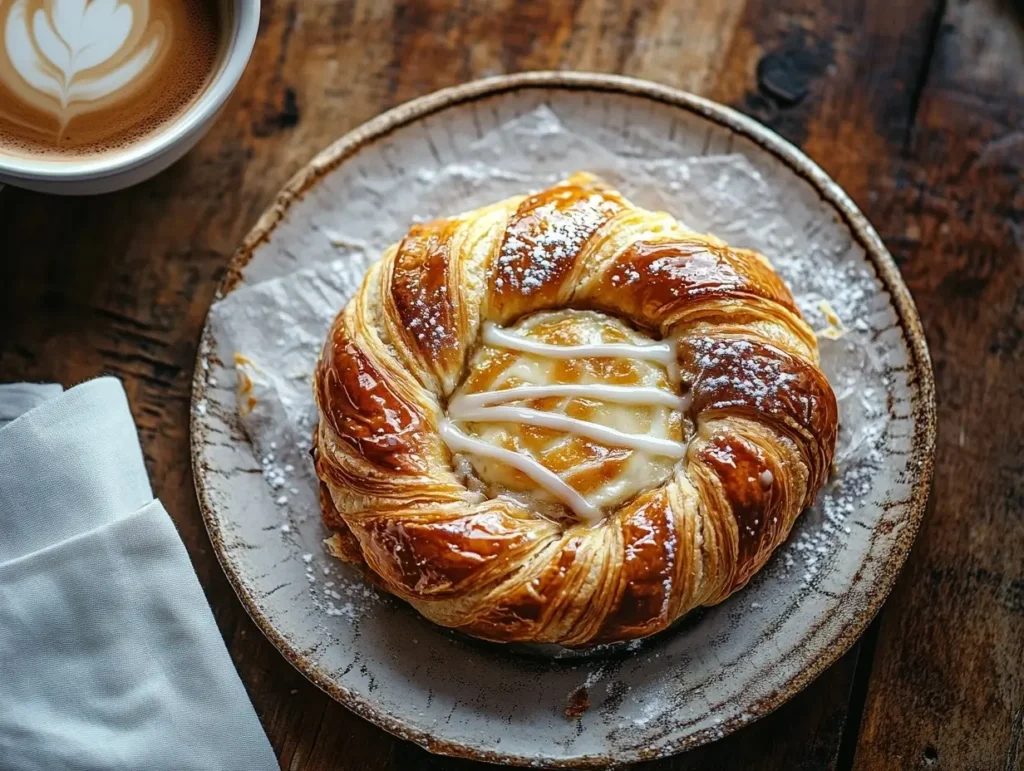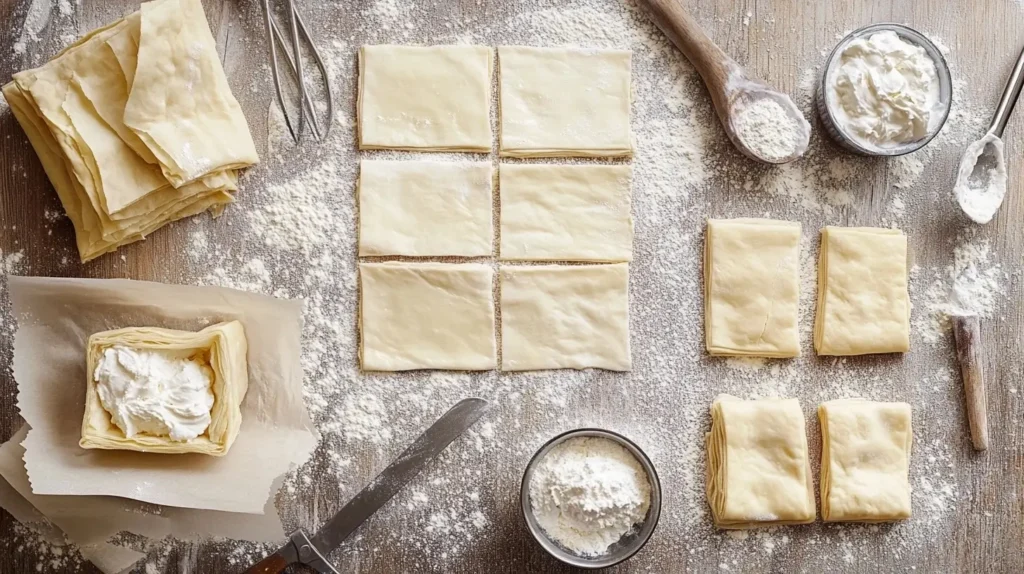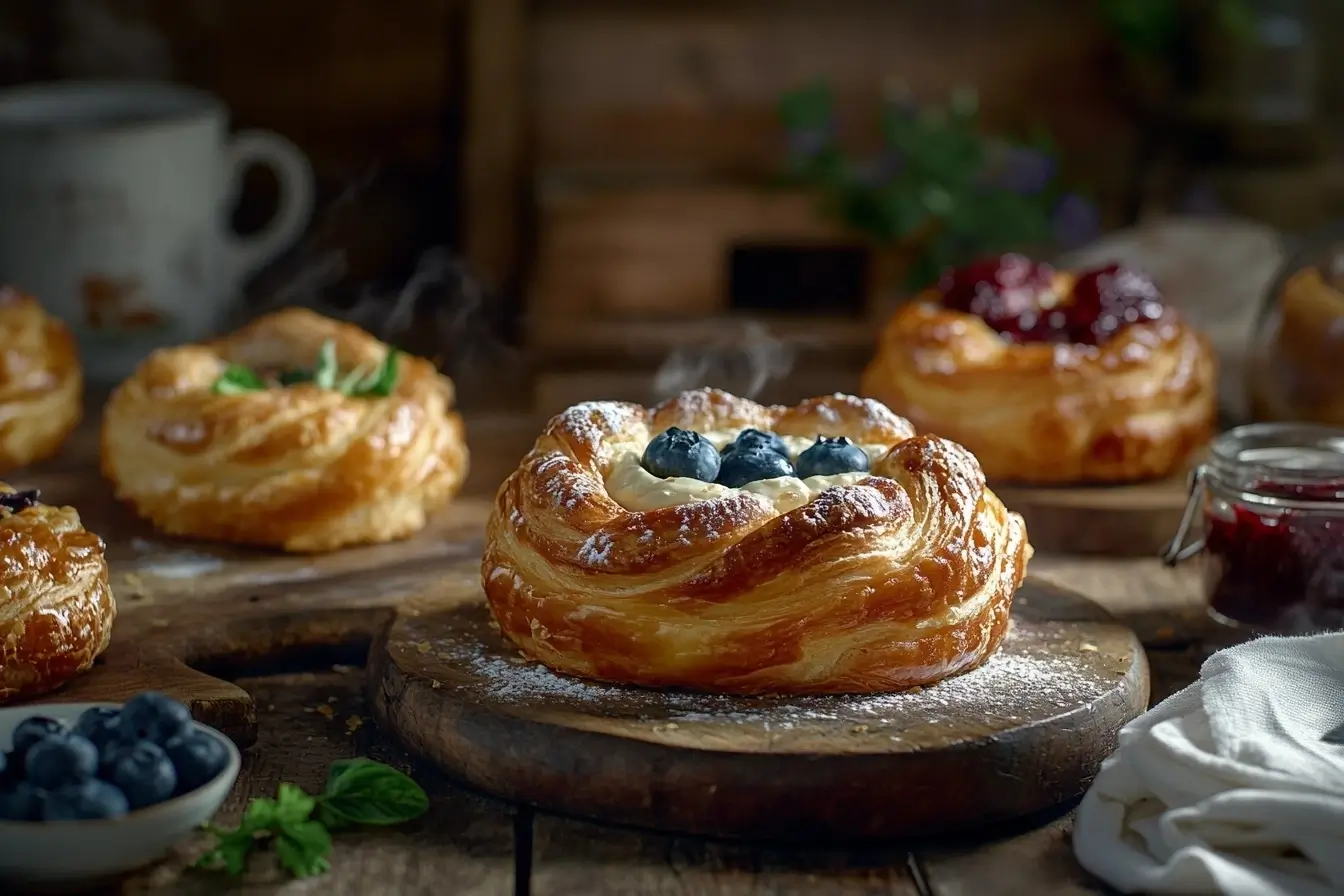Cheese Danish is a delicious pastry that has become a worldwide favorite, known for its golden, flaky crust and creamy filling. From its origins in Scandinavia to its adaptations in bakeries around the world, the Cheese Danish has evolved into a versatile treat. Whether you’re looking to learn how to bake one from scratch, experiment with unique flavors, or troubleshoot common baking issues, this guide has everything you need. So, grab your apron and let’s uncover the secrets to making the perfect cheese Danish.
What is a Cheese Danish?
A Brief Introduction to Cheese Danish
The cheese Danish is a pastry that combines a light, buttery dough with a rich, creamy cheese filling. While it’s a common sight in bakeries today, its roots lie in European traditions, where pastries were often created as a way to elevate simple ingredients.
Popularity of Cheese Danish in Modern Pastries
In recent years, the Cheese Danish has seen a surge in popularity. Why? Its versatility and ease of customization make it an all-around crowd-pleaser. Whether you’re indulging in a classic version or savoring a blueberry-topped twist, there’s no denying its appeal.
Why Cheese Danish is Loved Worldwide
What makes the cheese Danish so irresistible is its perfect balance of textures and flavors. The flaky pastry contrasts beautifully with the creamy filling, creating a bite that’s both satisfying and indulgent. Plus, it’s easy to enjoy as a breakfast item, dessert, or even a snack with a warm cup of coffee.

The History of Cheese Danish: Origins and Evolution
The origins of the cheese Danish trace back to the 19th century in Denmark, where bakers sought to create pastries that were both delicate and satisfying. Known as “Wienerbrød” (Viennese bread), these pastries were influenced by Austrian baking techniques brought to Denmark by immigrant bakers. The introduction of laminated dough—a process that involves folding butter into dough multiple times—gave these pastries their signature flakiness. Early Danish pastries were often filled with jams, custards, or nuts, but the addition of cream cheese filling later became a game-changer.
Introduction to America: How It Became a Bakery Staple
The cheese Danish made its way to the United States in the early 20th century, brought over by Danish immigrants. Its rich, creamy texture quickly captivated American taste buds, and bakers began experimenting with the recipe to suit local preferences. Over time, the pastry became a staple in cafes, bakeries, and diners, often served as part of a breakfast spread. The convenience of ready-made puff pastry dough also helped popularize its preparation at home.
Modern Adaptations and Variations Over Time
Today, the cheese Danish has gone through countless transformations. From adding fruit toppings like blueberries and raspberries to incorporating savory ingredients such as spinach and herbs, the pastry has evolved to cater to every palate. Bakers around the world have embraced regional ingredients and flavors, giving the Cheese Danish a global identity that reflects both its humble beginnings and its widespread appeal.
Ingredients You’ll Need
Dough Ingredients: Puff Pastry or Yeast Dough?
The foundation of a perfect cheese Danish lies in the dough. You can opt for a classic yeast dough for a softer, more traditional texture or go with puff pastry for a flaky, buttery bite. Puff pastry is a popular choice for home bakers due to its convenience and ability to produce a professional finish. If you’re feeling adventurous, making dough from scratch adds a personal touch.
Filling Essentials: Cream Cheese, Sugar, and Beyond
At the heart of every cheese Danish is the rich, velvety filling. Cream cheese, sweetened with sugar and often enhanced with a hint of vanilla or lemon zest, creates the perfect creamy center. Some recipes also call for sour cream or mascarpone to add depth of flavor.
Optional Ingredients for Flavors and Garnishes
To make your cheese Danish stand out, consider adding fruit preserves, fresh berries, or a drizzle of chocolate. For a savory twist, fillings like spinach and feta or sun-dried tomatoes work wonders. Garnishes like powdered sugar, slivered almonds, or a dollop of whipped cream can also elevate its presentation.
Step-by-Step Recipe for Cheese Danish
Preparing the Dough for Optimal Texture
Begin with puff pastry or your homemade yeast dough. Roll it out evenly on a floured surface, ensuring it’s thin enough for a flaky result but sturdy enough to hold the filling. Cut the dough into squares or rectangles for individual portions.
Crafting the Cream Cheese Filling
In a bowl, blend softened cream cheese, sugar, and vanilla extract until smooth. For a tangy twist, add a touch of lemon zest or a dollop of sour cream. The mixture should be creamy but firm enough to hold its shape during baking.
Assembling and Baking the Cheese Danish
- Place a spoonful of the cream cheese filling in the center of each dough piece.
- Fold or crimp the corners to partially cover the filling, forming the classic Danish shape.
- Transfer to a parchment-lined baking sheet and brush with egg wash for a golden finish.
- Bake at 375°F (190°C) for 15-20 minutes or until golden brown.
| Ingredient | Quantity | Purpose |
|---|---|---|
| Puff Pastry | 1 sheet (or homemade equivalent) | Base for the pastry |
| Cream Cheese | 8 oz (softened) | Key filling ingredient |
| Granulated Sugar | 1/3 cup | Sweetener for the filling |
| Vanilla Extract | 1 tsp | Flavor enhancer |
| Lemon Zest (optional) | 1 tsp | Adds brightness to the filling |
| Egg | 1 (beaten) | Egg wash for golden crust |

Step-by-Step Guide: How to Perfectly Glaze Your Cheese Danish
Types of Glazes: Traditional, Lemon, or Sugar-based
Glazing is the final touch that makes a cheese Danish shine. Choose a classic sugar glaze made from powdered sugar and milk, a tangy lemon glaze for added zest, or a simple syrup glaze for a glossy finish.
Tips for Achieving a Glossy Finish
- Allow the Danish to cool slightly before applying the glaze.
- Use a pastry brush or spoon for an even application.
- Adjust glaze consistency with milk or powdered sugar for desired thickness.
Common Mistakes to Avoid While Glazing
- Glazing while too hot: This can cause the glaze to melt and run.
- Over-glazing: Too much can overpower the delicate flavors.
- Using uneven consistency: A too-thin glaze won’t stick properly.
Creative Twists: Unique Cheese Danish Flavors
Sweet Variations: Blueberry, Raspberry, and Chocolate
Adding a fruity or indulgent twist to a cheese Danish takes it to the next level. Fresh blueberries or raspberries can be layered on top of the cream cheese filling before baking, creating a burst of natural sweetness. Chocolate lovers can incorporate a drizzle of melted chocolate or even mix cocoa into the filling for a rich, decadent treat. For a fusion of flavors, try combining fruits with chocolate—raspberries and dark chocolate are a match made in heaven.
Savory Cheese Danish: Spinach, Feta, and Herb Options
Who says cheese Danish has to be sweet? Savory versions are a delicious alternative. Fillings like spinach and feta, spiced with garlic or nutmeg, make for an elegant appetizer or brunch option. Herbs such as dill or thyme add a fresh note that complements the creaminess of the cheese. Try topping the savory Danish with sesame seeds or a sprinkling of grated Parmesan for added flair.
Seasonal Takes: Pumpkin Spice, Eggnog, and More
Seasonal flavors can make a cheese Danish feel festive. In fall, pumpkin spice blends seamlessly with the creamy filling, while winter calls for eggnog-infused cream cheese topped with a light dusting of nutmeg. In spring, lemon curd or strawberry fillings bring a bright and refreshing vibe. With a little creativity, you can transform this classic pastry into a celebration of any season.

Cheese Danish Around the World: Regional Variations and Similar Pastries
Comparing Cheese Danish with Italian Sfogliatella
Italy’s sfogliatella, known for its crisp, layered dough, shares some similarities with the cheese Danish. Both pastries rely on laminated dough for their texture, but sfogliatella is typically filled with ricotta cheese and citrus zest rather than cream cheese. Its shell-like shape and rich heritage make it a standout counterpart.
Central European Kolache and Their Similarities
Kolache, a pastry with origins in Central Europe, bears resemblance to the cheese Danish in its sweet, cheese-filled nature. Often made with a softer, bread-like dough, kolache is filled with cream cheese, fruit preserves, or poppy seeds. This traditional Czech pastry is a reminder of how different regions adapt similar ideas to create their own unique treats.
French Influence on the Danish Pastry Scene
The French influence is undeniable in Danish pastry-making. Techniques like laminating dough and using rich butter come directly from France’s baking traditions. The cheese Danish reflects this fusion, combining the indulgence of French pastries with Scandinavian ingenuity. In France, you’ll find relatives like pain aux raisins or croissants filled with cream cheese, showing how the two styles often overlap.
Troubleshooting Common Cheese Danish Baking Issues
Solving Soggy Crust Problems
A soggy crust can ruin the flaky perfection of a cheese Danish. To prevent this, ensure your dough is cold before baking. Overfilling the Danish is another culprit—use just enough filling to avoid moisture seeping into the crust. Baking on a preheated baking stone or steel can also help create a crisp base.
Preventing Filling Leakage
Filling leakage often occurs if the edges of the dough aren’t sealed properly. When folding, press the edges firmly to secure them. Brushing a small amount of water or egg wash along the edges acts like glue. Additionally, avoid overloading the Danish with filling, as excess can bubble out during baking.
Getting Even Baking Every Time
Uneven baking is a common issue, but rotating the tray halfway through baking can solve it. Always bake cheese Danish in the center of the oven to promote even heat distribution. If using puff pastry, ensure it’s rolled out evenly, as thickness variations can lead to inconsistent results.
Serving Suggestions for Cheese Danish: Pairings and Presentation Ideas
Perfect Beverages to Complement Cheese Danish
The cheese Danish pairs wonderfully with coffee or tea. For a refreshing option, try serving it with freshly squeezed orange juice or iced tea. Warm milk can be a comforting choice for kids, while herbal teas like chamomile enhance the pastry’s richness.
Creative Ways to Serve at Brunch or Dessert Tables
At brunch, arrange mini cheese Danishes on a tiered platter for an elegant touch. For dessert, serve with a scoop of vanilla ice cream or a drizzle of fruit syrup. Individual portions make them easy to grab, while decorative plates or trays elevate the presentation.
Garnishes and Plate Styling Ideas
Dusting the top with powdered sugar or cocoa powder adds a classic finish. Fresh berries or mint leaves can act as natural garnishes, enhancing both flavor and appearance. Serve on a wooden board with small bowls of jam or whipped cream to create an inviting display.
How to Make Cheese Danish Healthier Without Sacrificing Flavor
Using Low-Fat or Vegan Ingredients
Swap full-fat cream cheese with a low-fat or plant-based alternative. Coconut-based cream cheese or cashew cream provides similar creaminess for vegan diets. For the dough, use vegan puff pastry or prepare a homemade version with coconut oil instead of butter.
Reducing Sugar While Retaining Sweetness
Use natural sweeteners like honey or maple syrup in place of granulated sugar. Stevia or monk fruit sweetener works well for those watching their sugar intake. Adding fresh fruit like berries can also boost natural sweetness while cutting back on processed sugars.
Incorporating Whole Grains into the Dough
For a heartier version, substitute a portion of all-purpose flour with whole wheat flour. Whole-grain pastry flour maintains a tender texture while adding fiber and nutrients. You can also experiment with spelt flour or almond flour for unique flavors and healthier options.
Using natural sweeteners like honey or maple syrup instead of processed sugar can significantly reduce calorie intake while maintaining flavor. If you’re looking for more tips on healthy ingredient swaps and their benefits, check out this comprehensive guide on healthier eating.
Cheese Danish FAQs: Everything You Need to Know
Can You Freeze Cheese Danish?
Yes, cheese Danishes freeze exceptionally well, making them a convenient option for meal prep or storing leftovers. To freeze, let the pastries cool completely, then wrap them individually in plastic wrap or aluminum foil. Place the wrapped Danishes in an airtight container or freezer bag to prevent freezer burn. They can be stored for up to 2-3 months. To reheat, simply thaw them at room temperature and warm in an oven or toaster oven for a fresh-from-the-bakery experience.
How Long Can Cheese Danish Be Stored?
A cheese Danish can be stored at room temperature for up to 2 days if kept in an airtight container. If you want to extend their shelf life, refrigerate them for up to a week. Make sure they are tightly sealed to retain freshness. Avoid leaving them uncovered, as this can cause the pastry to dry out.
What Is the Danish Cheese That They Rent?
This question seems to be a mix-up. The pastry commonly known as a cheese Danish doesn’t use any specific type of Danish cheese. Instead, its creamy filling is usually made from sweetened cream cheese, which gives it its smooth and luscious texture.
For a deeper dive into Denmark’s best cheeses and their unique qualities, don’t miss Exploring Danish Cheeses: A Guide to Denmark’s Best Cheeses.
What is a Cheese Danish?
A cheese Danish is a pastry made with laminated dough (like puff pastry) filled with a sweetened cream cheese mixture. It’s a perfect blend of buttery, flaky layers and creamy sweetness.
For a detailed guide on its history, variations, and recipes, visit What is a Cheese Danish? A Guide to History, Variations, and Recipes.
How Many Calories in a Cheese Danish?
The calorie count varies depending on size and ingredients but typically ranges from 250 to 400 calories per serving. Homemade versions allow for calorie control by adjusting sugar and butter.
For a more detailed breakdown of calorie counts and nutritional insights, check out How Many Calories in a Cheese Danish? A Complete Guide.
Do Cheese Danishes Need to Be Refrigerated?
Yes, because of the cream cheese filling, cheese Danishes are best stored in the refrigerator to prevent spoilage.
What Does Cheese Danish Taste Like?
A cheese Danish offers a delightful combination of flavors: the buttery, flaky crust contrasts beautifully with the creamy, tangy-sweet cheese filling, making it both indulgent and comforting.
Why Are Danish Pastries So Good?
The magic lies in the laminated dough technique. By layering butter and dough, Danish pastries achieve their signature flakiness. When combined with high-quality fillings like cream cheese, fruits, or custards, the result is irresistible.
Why Is a Cheese Danish Called a Danish?
The name “Danish” originates from the pastry’s Scandinavian roots. Although similar pastries exist elsewhere, the technique and variations perfected in Denmark gave the pastry its name.
To dive deeper into the fascinating history behind this name, visit Why Is a Cheese Danish Called a Danish? The Delicious Story Behind the Name.
Conclusion: Why This Pastry is Worth the Effort
This pastry is more than just a treat; it’s a perfect blend of buttery, flaky layers and creamy, luscious filling that hits all the right notes. Its versatility makes it a favorite for any occasion, whether you’re enjoying it as a breakfast indulgence, a brunch star, or a simple yet elegant dessert. From humble beginnings in Scandinavia to its global popularity today, this pastry has become a timeless classic.
What makes it truly special is its adaptability. Sweet variations like blueberry or raspberry, or savory twists such as spinach and feta, mean there’s something to satisfy every taste. Seasonal spins bring even more fun, and finishing touches like glazes or garnishes add a creative flair to every batch.
Though baking this pastry from scratch takes a bit of patience, the rewards are undeniably worth it. There’s nothing quite like the joy of creating your own baked goods, experimenting with different flavors, and sharing them with family and friends. Whether you’re new to baking or have years of experience, this pastry offers a fantastic way to express your creativity. So grab your tools, fire up the oven, and enjoy the satisfaction of making something truly delightful!

